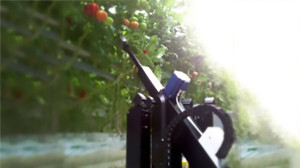Priva Developing Deleafing Robot For Tomatoes

When the Priva robot finds a leaf, it removes it with a cutting module specially mounted on a robot arm.
A few years ago, Priva faced a difficult request from its Dutch customers who grew tomatoes: to develop a robot that could remove leaves from tomato plants in the greenhouse completely independent of human assistance. They were looking for a robot that would mimic the performance of a human, but was also economically viable. Nobody had yet been able to design and market such a robot.
Now, with input from this group of growers, Priva has developed such a device and is using it as the foundation for automating various crop procedures in the greenhouse. Deleafing is only one of the applications, and the tomato is only one of the crops.
The lowest leaves of each plant are regularly removed in tomato growing to promote ripening. This process is called deleafing or leaf cutting, depending on the method used. Two to three leaves per plant are removed during this procedure, which is usually performed weekly by growers.
The fundamental challenge of automated deleafing is to identify the right leaves in a sea of green, and to remove them carefully within a short period of time. It is important that the leaf is removed as close to the stem as possible to prevent diseases such as botrytis from occurring in the crop.
Because every plant is different and light conditions always change, stringent requirements need to be met. For this reason, Priva developed a state-of-the-art vision-type technology. When the robot finds a leaf, it removes it with a cutting module specially mounted on a robot arm. The design of the robot arm and the cutting module is as compact as possible to allow the machine to move through the crop without damaging it. The components are designed to effectively resist contamination and the damaging effects of tomato sap.
To be economically viable, the robot must remove a large number of leaves per hour. This means the robot arm has to move quickly, and the vision technologies must determine the position of the leaves quickly and reliably.
The point of reference is the current level of labor costs. Throughout the project, Priva continuously monitored the robot to determine if using it was economically viable. Testing inside the greenhouse played a big role in this.
The unique collaboration between Priva and its grower customers has been central to the project. On the one hand, there are growers who realize that labor eventually becomes a limiting factor for the performance of their business, and that the development of new technologies can prevent this. On the other hand, there are suppliers who share the same vision and do not shy away from taking on what is a high-risk challenge. All parties are investing in the deleafing robit, with about half of the Dutch tomato acreage involved. The development is further made possible thanks to a number of subsidy regulations and both local and national sponsors.
In addition to the investment agreements, the parties also agreed that revenues from the deleafing robot would flow back to all investors. Exchanging know-how is an important element for bringing the development to a successful outcome. Thus the growers, for example, are playing a crucial role in guaranteeing the practical applicability of the robot.
Over the course of time, various designs have been developed and tested. One important milestone was the time at which actual leaves could be removed from a plant with a test model. The initial results were impressive; however, the cutting quality and speed of the test model were still too low to be economically viable.
It became necessary to adapt the design. Following some preparatory research and a second test model, a prototype was developed with the potential to be both technically and economically successful. This prototype was extensively tested in practical conditions. Important parameters such as cutting quality, speed, and effectiveness now meet expectations, according to Priva. As a result, the project has moved into the next phase. Currently, manufacturer VDL, on behalf of Priva, is building an initial production series of the deleafing robot. These first robots will be deployed amongst a number of participating Dutch growers this year.










